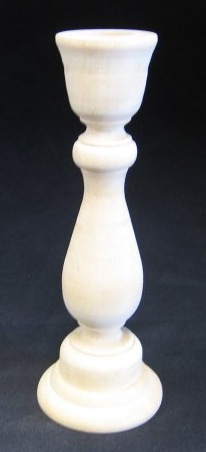Yesterday, I ordered 100 wood candlesticks. I suppose that it isn’t so surprising. After all, I do teach a lot of students and, candlesticks for Shabbat are a staple on everybody’s art experience agenda. I guess I ought to add that this is the second order of 100 wood candlesticks that I have placed since the current school year began.
So, here’s the deal and (and what a deal it is):
 Currently, at www.Bayerwood.com, you can order wood candlesticks (the tall spindle style) for only 25 cents apiece (50 cents/pair). Listed on the website as “repairable,” I can’t figure out what needs to be fixed. I cannot find the flaws! The candlesticks come in several sizes: 7 inch; 9 inch; 11 inch. I ordered the 9 inch, the first time, and this size has been well suited for all my students in 1st through 8th grade. Yesterday, I ordered the 7 inch size, just for variety.
Currently, at www.Bayerwood.com, you can order wood candlesticks (the tall spindle style) for only 25 cents apiece (50 cents/pair). Listed on the website as “repairable,” I can’t figure out what needs to be fixed. I cannot find the flaws! The candlesticks come in several sizes: 7 inch; 9 inch; 11 inch. I ordered the 9 inch, the first time, and this size has been well suited for all my students in 1st through 8th grade. Yesterday, I ordered the 7 inch size, just for variety.
As with any art experience, the outcome, even a stunning pair of Shabbat candlesticks, is only a ‘thing,’ a product, if the process is not accompanied by a bigger lesson. Creating a pair of Shabbat candlesticks (or Kiddush cup, or any ritual object for that matter) is truly a remarkable experience. This week, I asked 1st and 2nd graders to consider that, as artists, they are taking a 25 cent piece of flawed wood in order to transform it into something kodesh, an item imbued with sanctity. These young students eagerly gave serious thought to the difference between the 25 cent piece of so-called, “repairable” wood and a Shabbat candlestick. It didn’t take them long:
“You decorate it extra beautifully.”
“You plan to use it for a special reason.”
“You work with all your heart!”
This was my cue to further the lesson and introduce hiddur mitzvah, the commandment to beautify. When we fulfill this mitzvah, we further our individual and unique relationship with God. It is like giving someone you love a surprise that you just know, for sure, will make them happy. Being the giver becomes a precious gift in and of itself. All of a sudden, we are not just painting or gluing, we are engaging in a sacred dance. We are heightening an Eternal relationship.
In order to ensure that my students truly fulfill hiddur mitzvah, I give them easy to follow guidelines for individual, artistic, success:
Every artist must first paint the pair of candlesticks in one single color of acrylic paint. This year, green has been very popular, in addition to the more traditional silver and gold. Two of my students even began with a coat of black paint and the final result was spectacular! Acrylic paint covers the wood fully with one coat and it dries rapidly. Acrylic paint does stain so, remember to send home a “dress for mess” notice and provide a smock for every artist. If you are working in a carpeted space, cover the floor, just in case. (I use Murphy’s Oil Soap to clean my brushes and any ‘oops!’ spots.)
Once the initial coat of paint is dry, students choose from several techniques for the next step(s). They can paint designs, again with acrylic, using a tiny brush, when desired, for precision. They can glue small beads or tiles. They can use Mod Podge and stickers, tissue, or other decorative paper, for a smooth, decoupage finish. They can wrap fine yarn, dipped in Mod Podge, around select areas of each candlestick. Your artists can even use a combination of these techniques for a truly exceptional finish.
More often than not, young students prefer paint over any other decorative option. It is so important to bear in mind that children make art differently than do adults. Guide your students to excellence in the style they select. To achieve a candlestick product in the style you prefer, make your own. Recently, I felt honored to be present when parents extolled their new purple, pink, and blue, polka dotted, silver Shabbat candlesticks!
No matter which technique and materials your students select. The candlestick pair must be coated in Mod Podge for a fine, finished look and to protect and enhance the completed work.
Before sending the candlesticks home, ask each student to reflect on the job s/he did. How did each young artist choose the colors and embellishments? What does it feel like to create something kodesh? These are such enduring learning moments and sacred opportunities between you and your students! Take photos for your own memory book and to display on your bulletin board. Savor everyone’s artistry for wonderful storytelling and recollection long after the days of the dedicated creative joy.
[Also, be sure to include a reminder, with each set of candlesticks that, they are made of wood. Even with metal bobische inserts, vigilance must always be exercised when burning candles in these masterpieces.] I have used www.BayerWood.com for many years. Their product quality, value and service have been exemplary.
Also…
Leaping briefly to a seemingly unrelated subject… October is the birth month of Jewish artist Roy Lichtenstein. Even your most cynical, reluctant artists will recognize his signature, comic book art and be eager to further their study and experience with the style of this influential artist.

